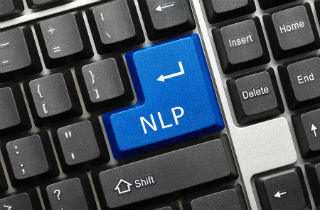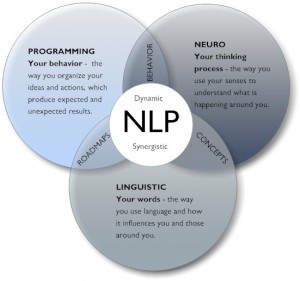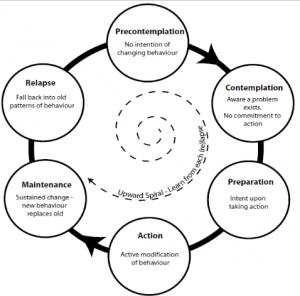Using NLP Techniques for Addiction
This article discusses whether NLP strategies work with clients experiencing addiction. The quick answer is – it depends upon client commitment, the client/counselor relationship, underlying issues, and effective interventions. To ensure greater success with clients experiencing addiction issues, counselors can:
- explore a client’s readiness for change using the Stages of Change
- build rapport
- identify goals and concerns
- determine effective NLP interventions
- Neuro-linguistic Programming
Neuro-linguistic Programming (NLP) is the study of subjective experience. The approach explores the connection between neurological processes, language, and experiential behaviors taken from https://www.quora.com/What-are-the-key-differences-between-NLP-and-NAC).
People can unlock their full potential and resolve issues, such as addiction, by employing NLP strategies. In summary, NLP is a set of powerful skills, a philosophy, and a useful attitude.
The Stages of Change Model
The Stages of Change Model is a framework that describes the process a person goes through to change a lifestyle habit such as addiction. A basic assumption of the model is that change does not occur in a single step, but is achieved through a series of distinct and predicable stages. I mention this because a counselor is more successful when he or she uses NLP strategies that are relevant to the client’s stage. The stages of change are as follows (https://www.lifeskillsresourcegroup.com/):
NLP strategies must be applied accordingly. For example:
Precontemplation Stage– Person has no intention of changing.
Possible NLP strategies:
- Outcome Specification
- Perceptual Positions
- Positive Intent
Contemplation Stage – Person is aware a problem exists, but has no desire to change.
Possible NLP strategies:
- Outcome Specification
- Reframing
- 6-step Reframe
Preparation Stage – Person is intent on making a change.
Possible NLP strategies:
- Core transformation
- Psychological attachments
- Logical levels
Action Stage – Person actively modifies behavior.
Possible NLP strategies:
- Decisions
- Anchors
- New Behavior Generator
Maintenance Stage – Person has made sustained change.
Possible NLP strategies:
- DMN and Stress Relief
- Identifying Negative Motivations
- Fast phobia cure
Relapse Stage – Person may return to old patterns of behavior.
Possible NLP strategies:
- Swish Pattern
- Dissociation and Association
- Submodalities
Hypothetical Client in the Preparation Stage
Jonathon is a veteran police officer employed by a large, metropolitan police department. He is also an alcoholic. Fifteen years of witnessing murders, child abuse, fatal traffic accidents and domestic violence as well as seeing offenders released indiscriminately has taken its toll. Jonathon loves police work; however, he has become increasingly cynical and callous. He was married and divorced twice. He also drinks a six-pack of beer nightly, is 25 pounds overweight, and is on paid administrative leave for allegedly abusing a suspect – a charge he does not deny.
Building rapport with Jonathon is fairly easy because I worked for a police department and understood the frustrations. His words suggest that his primary representational system is visual. He talks about “observing horrific situations,” “having nightmares,” and “not wanting to see the faces of the ‘perps’ who got away.” This wording leads me to observe Jonathon’s eye movements. As he recalls past events and constructs future thoughts, his eyes move up – to the right and left. Therefore, I ask questions such as “What do you see as the reason for your heavy drinking?” and “What do you picture yourself doing 10 years from now?”
Jonathon says he drinks excessively to hide chronic sorrow and depression. He is a “cop” and cops must be strong; so, he rejects all help and “toughs it out.” While he was ordered to attend counseling because of the abuse charges, he also realizes that he needs help. I determine that Jonathon is in the Preparation Phase of the Stages of Change Model.
Therefore; he is ready to change and with that in mind, I use the following NLP strategies:
- Logical Levels to better understand his thinking
- Psychological Attachments to discover underlying goals
- Core Transformation to understand what he truly wants in life
Logical Levels
I guide Jonathon through the Logical Levels exercise because I want to better understand what makes him “tick,” and I know that when change does not occur, exploring a client’s neurological levels can be helpful. The Levels and Jonathon’s responses regarding his drinking are below:
1. Environment Level – Refers to what is around the person when the behavior occurs.
Jonathon: Whenever I am with friends or home alone.
2. Behavior Level – refers to what the person does.
Jonathon: I drink lots of beer.
3. Capability Level – Refers to what a person can do.
Jonathon: I can drink a six-pack of beer – no problem. I have tried to stop many times; so I know what doesn’t work.
4. Belief Level – Refers to what a person thinks he or she can or should do.
Jonathon: I can’t stop drinking, but I really want to.
5. Identity Level – Refers to what a person thinks of him or herself.
Jonathon: I am a “cop” who drinks too much.
One place to intervene is at the Environment Level, Jonathon can change who he associates with, how he spends his time, and how much he drinks daily.
A second place to intervene is at the Belief Level. Jonathan believes he can’t stop drinking. Yet, if he thought, “I haven’t found a way to stop drinking; but I will,” he might consider additional options. I know that interventions at a higher level impact the lower levels; so, this is my focus.
Psychological Attachments
I explain to Jonathon that the reason for his drinking is like a weed, and his limiting beliefs and emotions are like the stem and leaves of the weed. If the root of a weed is not pulled, the weed returns. Therefore, I want to address the root of his problematic drinking, so, it does not return. NLP Practitioners refer to the roots as psychological attachments.
Basically, there are three primary psychological attachments although there can be others. The three attachments we discuss are: control, deprivation, and rejection.
1. With an attachment to control – Individuals tend to feel controlled even though they resent being controlled and unwittingly behave in ways that encourage others to correct and monitor their behavior.
2. With an attachment to deprivation – Individuals tend to feel unfulfilled in life. They fill the void with unfulfilling behaviors such as an addiction.
3. With an attachment to rejection – Individuals tend to feel hurt, rejected, or criticized while unconsciously or unwittingly doing things that invite rejection or criticism.
Jonathon appears to have an attachment to deprivation. He seldom feels satisfied, avoids intimacy, represses his feelings, and has addiction issues.
Core Transformation
A step in releasing Jonathon’s belief is to identify, at the deepest level, what he desires. ConnieRae Andreas, author of the book Core Transformations, describes five primary core states: Wholeness, Being, “Okness,” Inner Peace, and Love.
To help Jonathon identify his Core State, I ask a set of questions known as an Outcome Chain, which is basically a series of positive intentions for behavior. He responds in the following way:
- What does drinking do for you?
JONATHON – “Drinking drowns my feelings of sadness and doubt.”
- What does drowning your feelings of sadness and doubt do for you?
JONATHON – “Drowning my feelings allows me to have a brighter outlook on life.”
- What does having a brighter outlook on life do for you?
JONATHON – “A brighter outlook on life allows me to feel safe.”
- What does feeling safe do for you?
JONATHON – “Feeling safe allows me to have inner peace.”
- What does having inner peace do for you?
JONATHON – “That’s it.”
Inner Peace is Jonathon’s core state.
I ask Jonathan to think about how it would feel to have inner peace. He says that with inner peace, he feels safe, experiences less sadness and doubt, and has a brighter outlook on life. I then ask him to think about his need to drink given his feeling of inner peace. Jonathon says he doesn’t feel as if he wants a drink. This feeling may be challenged; however, there are strategies that can be taught to support the feeling of inner peace such as dissociation, anchoring, and maybe the swish pattern.
Questions about Using NLP in Substance Use Cases
In this article, we discussed ways that NLP strategies can be used and ones that are more likely to create success for the client. Please let us know your thoughts or questions by leaving us a note in the comments section. We do our best to respond to your comments personally.











Related Posts